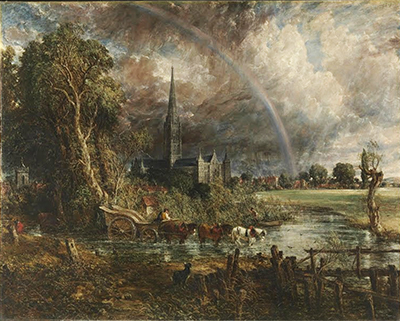To examine the image of Salisbury Cathedral from the Meadows is to take a sizeable leap back in time to discover the desires and belief systems of Constable.
Created in 1830, this work provides a snapshot view of a building not only close to Constable's faith, but also a testament to his friendship with Bishop John Fisher and his closeness to his nephew who was, at the time of painting, the Archdeacon of the city. Constable visited both regularly, staying with Bishop John Fisher on many occasions. Not just a spiritual home, but a source of artistic inspiration, the city and in particular, it's cathedral, was the subject for many of his works throughout the 1820s. Salisbury Cathedral from the Meadows can be described as a comment on the duality of life. It is a dramatic swirl of billowing clouds juxtaposed against the curvature of the tree on the left.
A north-westerly view with the artist perched across from the River Nadder. Note in the foreground the dense brambles which have been layered thickly with a palette knife; much like the dark brooding sky used as a symbol of life’s troubles. The heavy paintwork here is misaligned with the delicate hand-painted translucency of the rainbow which hangs above the cathedral and is focused upon by the sheepdog in the near foreground. The rainbow is believed to be a clear indication of the artist’s faith that even in dark, distressing times, such as those symbolised by the stormy weather, God and his church will heal all wounds.
But while many view this work as a reflection of Constable's religious nature, others have argued that it is vital to consider the positioning of the rainbow to understand its intent. The arc is thought to end at the Archdeacon's home, which some say illustrates his gratitude for his loving nephew, rather than a spiritual awakening. Their evidence points to a usual lack of symbolism in Constable's work, in favour of autobiographical content. In 1831 Constable exhibited Salisbury Cathedral from the Meadows in the Royal Academy, but no purchaser was found. It remained in his possession in his studio until 1837, where he tinkered with it and reworked it from time-to-time to achieve his vision of perfection. The rainbow was thought to be a later addition.




